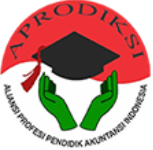Application of Accounting Scaffolding Learning Using Fingertips to Increase Learning Result
(1) SMA Negeri 5 Kupang, Indonesia
Abstract
The research aim to improve the student learning outcomes. Accounting scaffolding using fingertips is learning with scaffolding approach based on Zone of Proximal Development concept which uses the learning strategy/support given during a learning process based on Mnemonic Akrostik and Loci technique using fingertips that is applied at the accounting learning on journal material. This research used Classroom Action Research approach which conducted in two cycles and used the qualitative descriptive research method. The results of applying the scaffolding learning accounting using the fingertips are learning runs very well, unified nature of accounting scaffolding using the fingertips helps engaging the students and they are very active, enthusiastic/motivated and reduce frustration. It is an effective learning and it improves the students’ understanding to be more independent to achieve the learning objectives; application of accounting scaffolding learning using fingertips improves learning outcomes. The improved learning at cycle I, 78,1% is a good criteria and at cycle II, 90.6% is a good criteria, and the students’ activity at cycle I, 77% is a good criteria and at cycle II, 84% is a good criteria; and student response to learning is good because it is fun and can improve comprehension.
Keywords
Full Text:
PDFReferences
Alibali, M. (2006). Does visual scaffolding facilitate students’ mathematics learning? Evidence from early algebra. Retrieved February, 13, 2016.
Anghileri, J. (2006). Scaffolding practices that enhance mathematics learning. Journal of Mathematics Teacher Education, 9(1), 33-52.
Bransford, J., Brown, A., & Cocking, R. (2000). How people learn: Brain, mind, experience, and school: Expanded edition. Washington: National Academies Press.
Chang, K. E., Sung, Y. T., & Chen, I. D. (2002). The effect of concept mapping to enhance text comprehension and summarization. The Journal of Experimental Education, 71(1), 5-23.
Cowen, J., Blair, W., & Taylor, S. (2011). The use of scaffolding in the financial planning classroom: an Australian case study. Australasian Accounting, Business and Finance Journal, 5(3), 3-16.
Hartman, H. (2002). Scaffolding and cooperative learning. Human Learning an Instruction, 23-69.
Jaramillo, J. (1996). Vygotsky ’s Sociocultural Theory And Contributions To The Development Of Constructivist Curricula. Education, 117(1), 133-140.
Khanaliya, R. & Kusmuriyanto. (2017). Keefektifan Pembelajaran Akuntansi Materi Jurnal Penyesuaian dengan Metode Cooperative Script dan Resitasi. Economic Education Analysis Journal, 6(1), 207-217
McKenzie, J. (2000). Beyond Technology: Questioning, Research and the Information Literate School. FNO Press, 500 15th St., Bellingham, WA 98225.
Pardosi, L. (2012). Penerapan Kolaborasi Model Pembelajaran Number Head Together (NHT) Dengan Pendekatan Scaffolding Untuk Meningkatkan Motivasi Dan Hasil Belajar Akuntansi Siswa Pada Kompentensi Dasar Persamaan Dasar Akuntansi Di SMA Santo Yosep Medan. Dissertation. Medan: Universitas Negeri Medan.
Raymond, E. (2000). Cognitive Characteristics. Learners with Mild Disabilities (pp. 169-201). Needham Heights, MA: Allyn & Bacon, A Pearson Education Company.
Setyowati, A. T. (2012). Penerapan Scaffolding Learning Pada Mata Pelajaran Akuntansi Sebagai Upaya Meningkatkan Hasil Belajar (Study Pada Siswa Kelas XI IPS SMAN1 Kepanjen). Dissertation. Malang: Universitas Negeri Malang.
Sirait, M. (2012). Penerapan Model Pembelajaran Konstruktivisme Dengan Pendekatan Scaffolding Dalam Upaya Meningkatkan Aktivitas Dan Hasil Belajar Akuntansi Siswa Kelas X AKSMK YAPIM Medan T.A 2011/2012 Dissertation. Medan: Universitas Negeri Medan.
Triani, D., & Arief, S. (2016). Pengaruh Praktik Kerja Industri, Hasil Belajar Mata Pelajaran Akuntansi, Dan Motivasi Memasuki Kerja Terhadap Kesiapan Kerja Siswa Akuntansi. Economic Education Analysis Journal, 5(3), 849.
Widhiatmoko, I., & Khafid, M. (2014). Peningkatan Hasil Belajar Siswa Kompetensi Dasar Persamaan Akuntansi Melalui Pendekatan Pendidikan Karakter Menggunakan Metode Group Investigation. Dinamika Pendidikan, 9(2).
Winarti, W. (2013). Peningkatan Keaktifan Dan Hasil Belajar Siswa Pokok Bahasan Penyusutan Aktiva Tetap Dengan Metode Menjodohkan Kotak. Dinamika Pendidikan, 8(2)
Refbacks
- There are currently no refbacks.

This work is licensed under a Creative Commons Attribution 4.0 International License.

.png)

.png)





